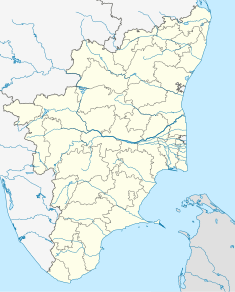
Tamil Jains are Tamils from Tamil Nadu, India, who practice Jainism. The Tamil Jain is a microcommunity of around 85,000, including both Tamil Jains and north Indian Jains settled in Tamil Nadu. They are predominantly scattered in northern Tamil Nadu, largely in the districts of Madurai, Viluppuram, Kanchipuram, Vellore, Tiruvannamalai, Cuddalore and Thanjavur. Early Tamil-Brahmi inscriptions in Tamil Nadu date to the 3rd century BCE and describe the livelihoods of Tamil Jains. Samaṇar wrote much Tamil literature, including the important Sangam literature, such as the Nālaṭiyār, the Silappatikaram, the Valayapathi and the Seevaka Sinthamaṇi. Three of the five great epics of Tamil literature are attributed to Jains.

Rajaraja I, born Arulmozhi Varman and often described as Raja Raja the Great, was a Chola emperor who reigned from 985 CE to 1014 CE. He was the most powerful king in south India during his reign and is remembered for reinstating the Chola influence and ensuring its supremacy across the Indian Ocean.

Chidambaram is a town and municipality in Cuddalore district in the Indian state of Tamil Nadu, on the banks of the Vellar River where it meets the Bay of Bengal. It is the headquarters of the Chidambaram taluk. The town is believed to be of significant antiquity and has been ruled, at different times, by the Pallavas until ninth century, Medieval Cholas, Later Cholas, Later Pandyas, Vijayanagar Empire, Thanjavur Nayakas, Marathas and the British. The town is known for the Thillai Nataraja Temple and Thillai Kali Temple, and the annual chariot festival held in the months of December–January and June to July. One of the Divya Desams Divya Sri Govindaraja Perumal Temple (Thiruchitrakoodam) is a part of Thillai Nataraja Temple complex. Thiruvetkalam Shiva Temple, Vadakiruppu, Thirunelvayil Shiva Temple, Sivapuri and Tirukkazhippalai Palvannanathar Temple are the other three ancient Shiva temples in the region.

Kanchipuram also known as Conjeevaram, is a city in the Indian state of Tamil Nadu in the Tondaimandalam region, 72 km (45 mi) from Chennai – the capital of Tamil Nadu. Known as the City of Thousand Temples, Kanchipuram is known for its temple architectures, 1000-pillared halls, huge temple towers and silk sarees. Kanchipuram serves as one of the most important tourist destinations in India. Kanchipuram has become a centre of attraction to the foreign tourists as well. The city covers an area of 36.14 km2 (13.95 sq mi) and an estimated population of more than 3,00,000 in 2021. It is the administrative headquarters of Kanchipuram District. Kanchipuram is well-connected by road and rail.

The Adikesava Perumal Temple is a Hindu temple located in Thiruvattar, Kanyakumari district, Tamil Nadu, India and is one of the 108 Divya desams, the holy sites of Hindu Vaishnavism according to existing Tamil hymns from the seventh and eighth centuries C.E. The temple is one of the historic thirteen Divya Deshams of Malai Nadu. The temple is a picturesque setting surrounded on three sides by rivers namely, It was the Rajya Temple and Bharadevatha shrine of Erstwhile Travancore. After state reorganisation, the temple handed over to Tamilnadu H&RCE Dept. The presiding Vishnu in the form of Ananthapadmabhan/Adikeshavaperumal is believed to be older than Padmanabhaswamy Temple in Thiruvananthapuram. Since Vishnu resides here in a reclining position, and is surrounded by rivers, the temple is called as "The Srirangam of Chera Kingdom".
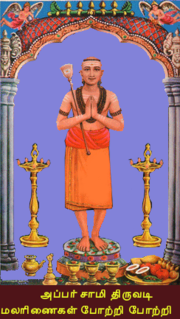
Appar, also referred to as Tirunāvukkarasar or Navukkarasar, was a seventh-century Tamil Śaiva poet-saint. Born in a peasant Śaiva family, raised as an orphan by his sister, he lived about 80 years and is generally placed sometime between 570 and 650 CE. Appar composed 4,900 devotional hymns to the god Shiva, out of which 313 have survived and are now canonized as the 4th to 6th volumes of Tirumurai. One of the most prominent of the sixty-three revered Nayanars, he was an older contemporary of Thirugnana Sambandar.
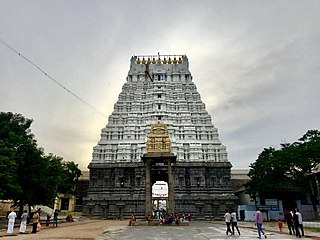
Varadharaja Perumal Temple, also called Hastagiri and Attiyuran, is a Hindu temple dedicated to Vishnu located in the city of Kanchipuram, Tamil Nadu, India. It is one of the Divya Desams, the 108 temples of Vishnu believed to have been visited by the 12 poet saints, or the Alvars. It is located in a suburb of Kanchipuram known as the Vishnu Kanchi that is a home for many famous Vishnu temples. One of the greatest Hindu scholars of Vaishnava Vishishtadvaita philosophy, Ramanuja, is believed to have resided in this temple.
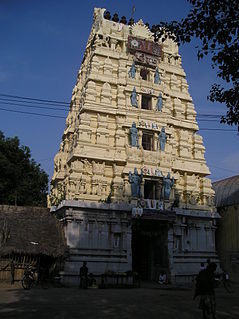
Madurantakam is a town and a municipality in Chengalpattu district in the Indian state of Tamil Nadu. The town is known for the artificial and second largest lake in Tamil Nadu, the Maduranthakam lake. It is said to have been built by the Chola King Uttama Chola, also called as Maduranthaka, during his reign. It is also home to the Eri-Katha Ramar Temple. As of 2011, the town had a population of 30,796.

Brihadishvara Temple locally known as Thanjai Periya Kovil, and also called Rajarajeswaram, is a Hindu Dravidian styled temple dedicated to the god Shiva located in South bank of Cauvery river in Thanjavur, Tamil Nadu, India. It is one of the largest Hindu temples and an exemplary example of a fully realized Tamil architecture. It is called as Dakshina Meru. Built by Chola emperor Rajaraja I between 1003 and 1010 CE, the temple is a part of the UNESCO World Heritage Site known as the "Great Living Chola Temples", along with the Chola dynasty era Gangaikonda Cholapuram temple and Airavatesvara temple that is about 70 kilometres (43 mi) and 40 kilometres (25 mi) to its northeast respectively.
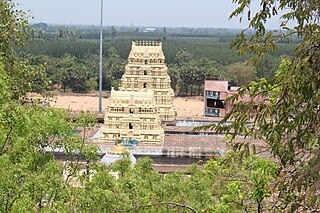
Devanathaswamy temple in Thiruvanthipuram, a village in the outskirts of Cuddalore in the South Indian state of Tamil Nadu, is dedicated to the Hindu god Vishnu. Constructed in the Dravidian style of architecture, the temple is glorified in the Divya Prabandha, the early medieval Tamil canon of the Azhwar saints from the 6th–9th centuries CE. It is one of the 108 Divyadesam dedicated to Vishnu, who is worshipped as Devanathaswamy and his consort Lakshmi as Hemabhujavalli. Though the presiding deity is Devanathaswamy, the temple is known for Hayagriva, the horse faced avatar of Vishnu, God of Knowledge. The temple is the only historical temple in South India to have a shrine of Hayagriva on hilltop.
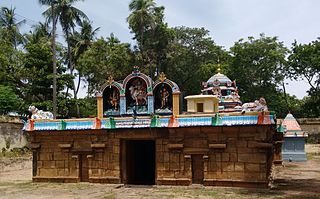
Chakramangai or Chakravageswarar Temple is a Hindu temple dedicated to Hindu deity Shiva and is located in Chakkarapalli, Papanasam taluk of Thanjavur district, Tamil Nadu, India. The temple is incarnated by the hymns of Thevaram, the 7th century Tamil literature and is classified as Paadal Petra Sthalam. It is one of the 275 Paadal Petra Sthalams, where the three of the most revered Nayanars, Appar and Tirugnana Sambandar have glorified the temple with their verses during the 7th-8th century. The temple has been widely expanded by Chola kings during the 11th century.
Hinduism in Tamil Nadu finds its earliest literary mention in the Sangam literature dated to the 5th century BCE. The total number of Tamil Hindus as per 2011 Indian census is 63,188,168 which forms 87.58% of the total population of Tamil Nadu. Hinduism is the largest religion in Tamil Nadu.
Jambai is a 1 km2 (0.39 sq mi) village in Tirukkoyilur taluk in Kallakurichi district in the Indian state of Tamil Nadu. The major occupation of the people living at this place is agriculture and handloom. In 2011, it had a population of 2,000 people.

Jainism has an extensive history in the Indian state of Tamil Nadu, although practiced by a minority of Tamils in contemporary times. According to the 2011 India Census, Jains represent 0.12% of the total population of Tamil Nadu, and are of the Digambara sect. Tamil Jains are primarily concentrated in northern Tamil Nadu, in the districts of Madurai, Viluppuram, Kanchipuram, Vellore, Tiruvannamalai, Cuddalore and Thanjavur.
Seeyamangalam is a small village in Vandavasi taluk in Tiruvannamalai district in the Indian state of Tamil Nadu. The major occupation of the people living at this place is agriculture. As of 2011, it had a population of 1665. The place is known for the Avanibhajana Pallaveshwaram temple.

Chandramowleeswarar Temple, Thiruvakkarai in Thiruvakkarai, a village in Villupuram district in the South Indian state of Tamil Nadu, is dedicated to the Hindu god Shiva. Constructed in the Dravidian style of architecture, the temple is believed to have been built during the Cholas period in the 10th century. The temple has received gracious endowments from the Chola queen Sembiyan Mahadevi. Shiva is worshipped as Chandramowleeswarar and his consort Parvathi as Amirthambigai.
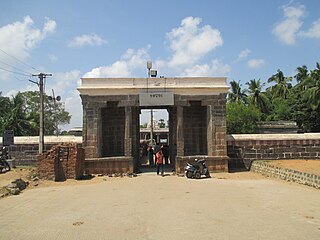
Nithyakalayana Perumal temple in Thiruvidandai, a village in Chennai, Chengalpattu district of the South Indian state of Tamil Nadu, is dedicated to Varaha, the boar avatar of the Hindu god Vishnu. Constructed in the Dravidian style of architecture, the temple is glorified in the Divya Prabandha, the early medieval Tamil canon of the Azhwar saints from the 6th–9th centuries AD. It is one of the 108 Divyadesam dedicated to Vishnu, who is worshipped as Nithyakalayana Perumal (Varaha) and his consort Lakshmi as Komalavalli Thayar. The original structure of the temple was built by the Pallavas during the 7th century CE, with later additions from the Cholas during the 11th century.
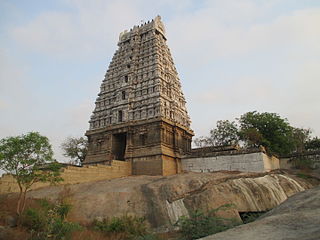
Atulya Nadheswarar Temple is a Hindu temple dedicated to the deity Shiva, located in Arakandanallur, a town panchayat in Viluppuram district in the South Indian state of Tamil Nadu. Shiva is worshipped as Atulya Nadheswarar, and is represented by the lingam. His consort Parvati is depicted as Azhagiya Ponnazhagi. The presiding deity is revered in the 7th century Tamil Saiva canonical work, the Tevaram, written by Tamil saint poets known as the Nayanars and classified as Paadal Petra Sthalam.
Manimangalam is a small town located in the Kanchipuram district of Tamil Nadu state in Southern India, famous for its ancient temples and inscriptions documenting the history of the ancient Tamil kings
